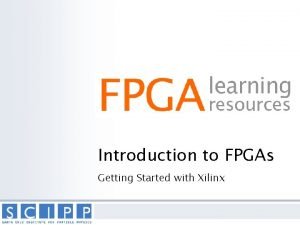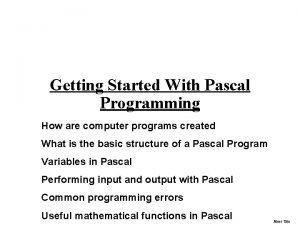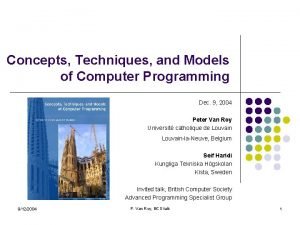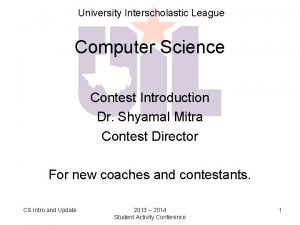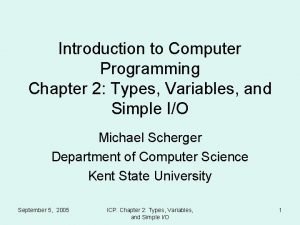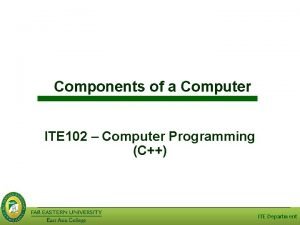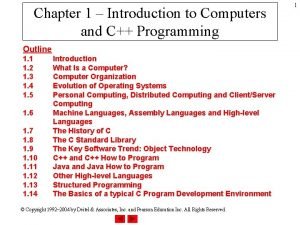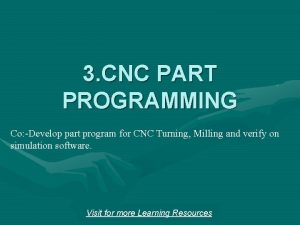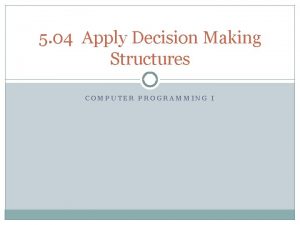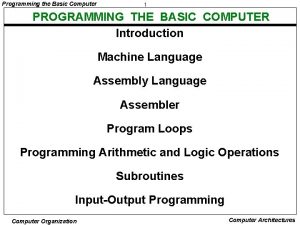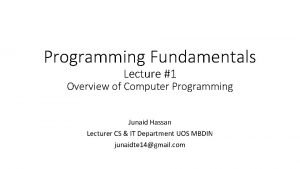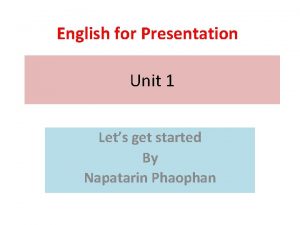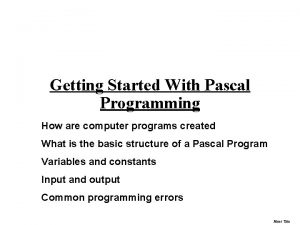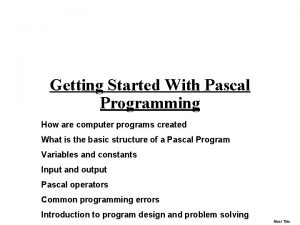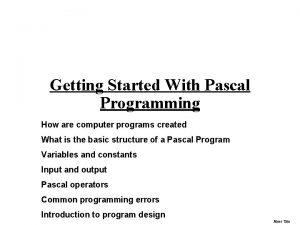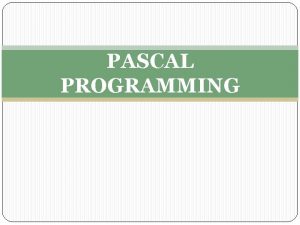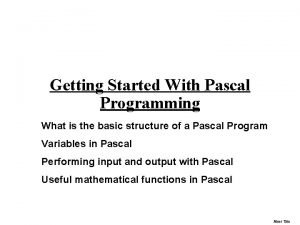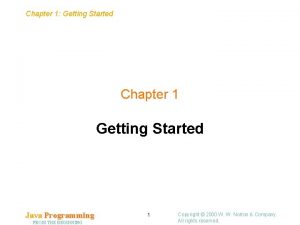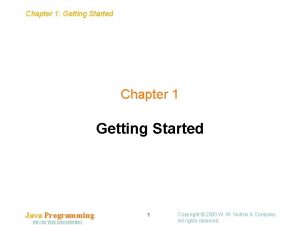Getting Started With Pascal Programming How are computer























































- Slides: 55

Getting Started With Pascal Programming How are computer programs created What is the basic structure of a Pascal Program Variables and constants Input and output Pascal operators Common programming errors Introduction to program design James Tam

Computer Programs Binary is the language of the computer 1) A programmer writes a computer 2) The compiler program translates the program into a form that the computer can understand 3) An executable program is created 4. Anybody who has this executable installed on their computer can then run (use) it. James Tam

Translators Convert computer programs to machine language Types 1) Interpreters • Translate the program as it's executed (a part at a time). 2) Compilers • Translate the program before it's executed (all at once). James Tam

Compiling Programs: Basic View Pascal program filename. p Machine language program Pascal compiler input gpc output a. out James Tam

Compiling Programs On Different Operating Systems Solaris compiler a. out (Solaris) Pascal program Windows compiler a. out (Windows) Amiga. DOS compiler a. out (Amiga. DOS) James Tam

Basic Structure Of Pascal Programs Header Program documentation program name (input, output); Declarations const : Statements begin : end. James Tam

Details Of The Parts Of A Pascal Program Headers • Parts: 1) Program documentation - What does the program do, author(s), version number, date of last modification etc. - Comments for the reader of the program (and not the computer) (* Marks the beginning of the documentation *) Marks the end of the documentation 2) Program heading - Name of program, if input and/or output operations performed by the program • Example (* * Tax-It v 1. 0: This program will electronically calculate your tax return. *) program tax. It (input, output); James Tam

Details Of The Parts Of A Pascal Program (2) Declarations • List of constants • More to come later during this term Statements • • The instructions in the program that actually gets stuff done They tell the computer what to do as the program is running Each statement is separated by a semicolon "; " Much more to come later in the course James Tam

The Smallest Pascal Program program smallest; begin end. Note: The name "smallest" should match the filename "smallest. p". You can find an online version of this program in the Unix file system under /home/231/examples/intro/smallest. p (the compiled version is called "smallest"). James Tam

Creating And Compiling Programs: On The Computer Science Network Text editor To begin creating the Pascal program, in Unix type "XEmacs filename. p" XEmacs Pascal program filename. p (Unix file) Pascal compiler gpc Machine language program To compile the program, in Unix type "gpc filename. p" a. out (Unix file) To run the program, in Unix type ". /a. out" James Tam

Variables Set aside a location in memory Used to store information (temporary) Types: • integer – whole numbers • real – whole numbers and fractions - Can't start or end with a decimal • char – alphabetic, numeric and miscellaneous symbols • boolean – true or false values Usage: • Declaration • Accessing or assigning values to the variables Picture from Computers in your future by Pfaffenberger B James Tam

Declaring Variables Sets aside memory Memory locations addressed through the name RAM Name of variable RESERVED James Tam

Declaring Variables (2) The declaration occurs between the begin and the end statements. Header Program documentation program name (input and output operations); Declarations const : Statements begin Declare variables here end. James Tam

Declaring Variables (3) Format: var name of first variable : type of first variable; var name of second variable: type of second variable; Examples: var height: real; var weight: real; var age: integer; James Tam

Variable Naming Conventions • Should be meaningful • Any combination of letters, numbers or underscore (can't begin with a number and shouldn't begin with an underscore) • Can't be a reserved word (see the “Reserved Words” slide) • Avoid using predefined identifiers (see the “Standard Identifiers” slides) • Avoid distinguishing variable names only by case • For variable names composed of multiple words separate each word by capitalizing the first letter of each word (save for the first word) or by using an underscore. James Tam

Variable Naming Conventions (2) • Okay: - tax_rate - first. Name • Not Okay (violate Pascal syntax) - 1 abc test. msg good-day program • Not okay (bad style) -x - wrintln James Tam

Reserved Words Have a predefined meaning in Pascal that cannot be changed and array begin case const div do downto else end file forward function goto if in label mod nil not of or packed procedure program record repeat set then to type until var while For more information on reserved words go to the url: http: //www. gnu-pascal. de/gpc/index. html James Tam

Standard Identifiers Have a predefined meaning in Pascal that SHOULD NOT be changed Predefined constants • false • true • maxint Predefined types • • • boolean char integer real text Predefined files • input • output For more information on standard identifiers go to the url: http: //www. gnu-pascal. de/gpc/index. html James Tam

Standard Identifiers (2) Predefined functions abs arctan chr cos eof eoln exp ln odd ord pred round sin sqrt succ trunc For more information on standard identifier go to the url: http: //www. gnu-pascal. de/gpc/index. html James Tam

Standard Identifiers (3) Predefined procedures dispose get new pack page put readln reset rewrite unpack writeln For more information on standard identifier go to the url: http: //www. gnu-pascal. de/gpc/index. html James Tam

Accessing Variables Can be done by referring to the name of the variable Format: name of variable Example: num James Tam

Assigning Values To Variables Format: Destination : = Source; 1 Example: grade : = 100; age : = median; interest : = principle * rate; initial : = ‘j’; 1 The source can be any expression (constant, variable or mathematical formula) James Tam

Assigning Values To Variables (2) Avoid assigning mixed types: program variable. Example; begin var num 1 : integer; var num 2: real; num 1 : = 12; num 2 : = 12. 5; num 2 : = num 1; Not allowed! num 1 : = num 2; end. James Tam

Named Constants A memory location that is assigned a value that cannot be changed Declared in the constant declaration ("const") section The naming conventions for choosing variable names also applies to constants but the name of constants should be all UPPER CASE. (You can separate multiple words with an underscore). Format: const NAME_OF_FIRST_CONSTANT = value of first constant; NAME_OF_SECOND_CONSTANT = value of second constant; etc. James Tam

Named Constants (2) Examples: const TAX_RATE = 0. 25; SAMPLE_SIZE = 1000; YES = True; NO = False; James Tam

Location Of Named Constants The declaration occurs in the declaration section. Header Program documentation program name (input and output operations); Declarations const Declare constants here Statements begin end. James Tam

Purpose Of Named Constants 1) Makes the program easier to understand population. Change : = (0. 1758 – 0. 1257) * current. Population; Vs. Magic Numbers (avoid!) const BIRTH_RATE = 0. 1758; DEATH_RATE = 0. 1257; begin population. Change : = (BIRTH_RATE – DEATH_RATE) * current. Population; James Tam

Purpose Of Named Constants (2) 2) Makes the program easier to maintain • If the constant is referred to several times throughout the program changing the value of the constant once will change it throughout the program. James Tam

Purpose Of Named Constants (3) program population (output); const BIRTH_RATE = 0. 1758; DEATH_RATE = 0. 1257; begin var population. Change : real; var current. Population : real; population. Change : = (BIRTH_RATE - DEATH_RATE) * current. Population; if (BIRTH_RATE > DEATH_RATE) then writeln('Growing population') else if (BIRTH_RATE < DEATH_RATE) then writeln('Shrinking population') end. James Tam

Purpose Of Named Constants (3) program population (output); const BIRTH_RATE = 0. 5; DEATH_RATE = 0. 1257; begin var population. Change : real; var current. Population : real; population. Change : = (BIRTH_RATE - DEATH_RATE) * current. Population; if (BIRTH_RATE > DEATH_RATE) then writeln('Growing population') else if (BIRTH_RATE < DEATH_RATE) then writeln('Shrinking population') end. James Tam

Purpose Of Named Constants (3) program population (output); const BIRTH_RATE = 0. 5; DEATH_RATE = 0. 01; begin var population. Change : real; var current. Population : real; population. Change : = (BIRTH_RATE - DEATH_RATE) * current. Population; if (BIRTH_RATE > DEATH_RATE) then writeln('Growing population') else if (BIRTH_RATE < DEATH_RATE) then writeln('Shrinking population') end. James Tam

Output Displaying information onscreen Done via the write and writeln statements Format: write ('text message'); or writeln('text message'); write(name of variable or constant); or writeln (name of variable or constant); write('message', name of variable, 'message'…); or writeln('message', name of variable, 'message'…); James Tam

Output (2) Example: program simple (output); begin writeln(‘This it it. ’); end. James Tam

Output (3) Examples: var num : integer; num : = 10; writeln('line 1'); write('line 2 A'); writeln('line 2 B'); writeln(num); writeln('num=', num); James Tam

Formatting Output Automatic formatting of output • Field width: The computer will insert enough spaces to ensure that the information can be displayed. • Decimal places: For real numbers the data will be displayed in exponential form. Manually formatting of output: Format: write or writeln (data: Field width for data: Number decimal places for data); Examples num : = 12. 34; writeln(num); writeln(num: 5: 2); James Tam

Formatting Output (2) If the field width doesn’t match the actual size of the field • Field width too small – extra spaces will be added for numerical variables but not for other types of data. • Examples: num : = 123456; writeln(num: 3); writeln('123456': 3); • Field width too large – the data will be right justified (extra spaces will be put in front of the data). • Examples: num : = 123; writeln(num: 6); writeln('123': 6); James Tam

Formatting Output (3) If the number of decimal places doesn’t match the actual number of decimal places. • Set number of decimal places less than the actual number of decimal places – number will be rounded up. • Example: num 1 : = 123. 4567; writeln (num 1: 6: 2); • Set number of decimal places greater than the actual number of decimal places – number will be padded with zeros. • Example: num 1 : = 123. 4567; writeln(num 1: 6: 6); James Tam

Formatting Output: A Larger Example For the complete program and executable look under /home/231/examples/intro/out 1. p (out 1 for the compiled version) program out 1 (output); begin var num 1 : integer; var num 2 : real; num 1 : = 123; num 2 : = 123. 456; writeln('Auto formatted by Pascal', num 1, num 2); writeln('Manual format': 13, num 1: 3, num 2: 7: 3); writeln('Manual not enough': 13, num 1: 2, num 2: 6: 3); writeln('Manual too much': 16, num 1: 4, num 2: 8: 4); end. James Tam

Input The computer program getting information from the user Done via the read and readln statements Format: read (name of variable); or readln (name of variable); James Tam

Input (2) Examples: begin var num 1 : integer; var num 2 : integer; read (num 1); read (num 2); end. James Tam

Input: Read Vs. Readln Both: • Reads each value inputted and matches it to the corresponding variable. Read • If the user inputs additional values before hitting return they will remain Readln • Any additional values inputted before the return will be discarded James Tam

Input: Read Vs. Readln (An Example) For the complete version of this program look in Unix under: /home/231/examples/intro/read 1. p (or read 1 for the compiled version): begin var num 1 : integer; var num 2 : integer; write('Type in an integer: '); read(num 1); write('Type in an integer: '); read(num 2); writeln('You typed in the following numbers: '); writeln('First: ', num 1, ' Second: ', num 2); end. James Tam

Input: Read Vs. Readln (An example (2)) For the complete version of this program look in Unix under: /home/231/examples/intro/read 2. p (or read 2 for the compiled version) begin var num 1 : integer; var num 2 : integer; write('Type in an integer: '); readln(num 1); write('Type in an integer: '); readln(num 2); writeln('You typed in the following numbers: '); writeln('First: ', num 1, ' Second: ', num 2); end. James Tam

Another Use For Readln As an input prompt e. g. , writeln('To continue press return'); readln; James Tam

Performing Calculations Operation Symbol (Operator) Addition + Subtraction - Multiplication * Real number division / Integer division DIV Remainder (modulo) MOD James Tam

Common Programming Errors Syntax/compile errors Runtime errors Logic errors James Tam

Syntax/Compile Errors Text editor XEmacs Pascal program filename. p (Unix file) Pascal compiler gpc Syntax error: No executable (a. out) produced. James Tam

Runtime Errors Text editor XEmacs Pascal program filename. p (Unix file) Pascal compiler gpc Machine language program a. out (Unix file) Executing a. out Runtime error (execution stops) James Tam

Logic Errors Text editor XEmacs Pascal program filename. p (Unix file) Pascal compiler gpc Machine language program a. out (Unix file) Executing a. out Program finishes executing but may produce an incorrect result James Tam

Approaches To Program Design 1. Top down • Plan out your approach prior to working on the details of your solution. 2. Bottom up • Immediately start working on details of your solution without any sort of structure for your approach. James Tam

Top Down Design 1. Start by outlining the major parts (structure) My autobiography Chapter 1: The humble beginnings Chapter 2: My rise to greatness … 2. Then implement the solution for each part Chapter 1: The humble beginnings It all started seven and one score years ago with a log-shaped work station… James Tam

Bottom Up Design 1. Start implementing a solution without creating a structure or plan. Here is the first of my many witty anecdotes, it took place in a Paris cafe… James Tam

You Should Now Know What are different the types of translators and the differences between them What is the basic structure of a Pascal program How to create, compile and run Pascal programs on the Computer Science network Variables: • • What are they and what are they used for How to set aside memory for one through a declaration How to access and change their values Conventions for naming variables James Tam

You Should Now Know (2) Constants: • What are named constants and how do they differ from variables • How to declare a constant • What are the benefits of using constants Output: • How to display text messages or the value of variables onscreen with write and writeln • How to format the output of a program Input: • How to get a program to acquire and store information from the user of the program • What is the difference between read and readln James Tam

You Should Now Know (3) How are common mathematical operations performed in Pascal. What are three common programming errors, when do they occur and what is the difference between each one. What is the difference between top down and bottom up design. James Tam
 The secret of getting ahead is getting started
The secret of getting ahead is getting started Antigentest åre
Antigentest åre Getting started with vivado
Getting started with vivado Unix for bioinformatics
Unix for bioinformatics Splunk free training
Splunk free training Rancher slack
Rancher slack Getting started with excel
Getting started with excel Getting started with microsoft outlook learning
Getting started with microsoft outlook learning Getting started with xilinx fpga
Getting started with xilinx fpga Getting started with lua
Getting started with lua Unit 1 my hobbies
Unit 1 my hobbies Local environment getting started
Local environment getting started Unit 1 getting started
Unit 1 getting started Linkedin getting started
Linkedin getting started Getting started with vivado
Getting started with vivado Perl getting started
Perl getting started Getting started with ft8
Getting started with ft8 Listen and read unit 3
Listen and read unit 3 Unit 1 getting started
Unit 1 getting started Getting started with poll everywhere
Getting started with poll everywhere Android development getting started
Android development getting started Tipos de habilidades del pensamiento
Tipos de habilidades del pensamiento Getting started with eclipse
Getting started with eclipse Hakan kutucu
Hakan kutucu Pascal
Pascal Perbedaan linear programming dan integer programming
Perbedaan linear programming dan integer programming Greedy vs dynamic
Greedy vs dynamic System programming vs application programming
System programming vs application programming Integer programming vs linear programming
Integer programming vs linear programming Definisi linear
Definisi linear Nocti study guide
Nocti study guide Nanoprogram
Nanoprogram Concepts, techniques, and models of computer programming
Concepts, techniques, and models of computer programming Visual computer programming
Visual computer programming Vallath nandakumar
Vallath nandakumar Types of variables in computer programming
Types of variables in computer programming Programming raster display system in computer graphics
Programming raster display system in computer graphics Components of computer programming
Components of computer programming Computer programming chapter 1
Computer programming chapter 1 N in part programming
N in part programming Susanna s epp
Susanna s epp Chapter 1 introduction to computers and programming
Chapter 1 introduction to computers and programming History of python
History of python Computer programming with matlab
Computer programming with matlab Flair furniture company linear programming
Flair furniture company linear programming Decision making in computer programming
Decision making in computer programming Cir and cil are symbols of _________.
Cir and cil are symbols of _________. Programming fundamentals 1
Programming fundamentals 1 Python programming an introduction to computer science
Python programming an introduction to computer science When was globalization started
When was globalization started What was urdu hindi controversy
What was urdu hindi controversy When islam started
When islam started The r.a. no. 10912 was enacted on
The r.a. no. 10912 was enacted on History of samaritan's purse
History of samaritan's purse How to start a presentation
How to start a presentation Why cold war started
Why cold war started








